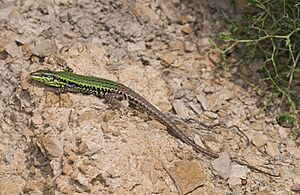Skyros wall lizard facts for kids
The Skyros wall lizard (Podarcis gaigeae) is a type of lizard that belongs to the Lacertidae family. This lizard is unique because it lives only on the islands of Skyros and Piperi in Greece. This means it is an endemic species, found nowhere else in the world!
Quick facts for kids Skyros wall lizard |
|
|---|---|
 |
|
| Conservation status | |
| Scientific classification |
Contents
What Makes Skyros Wall Lizards Special?
Skyros wall lizards are interesting because they can show "island gigantism." This means that on very small islands around Skyros, these lizards can grow much larger than their relatives on bigger islands.
They also have a cool feature called "throat color polymorphy." This means they can have six different colors on their throats! Both male and female lizards can show these different throat colors.
Meet the Skyros Wall Lizard
How Big Are They?
The Skyros wall lizard can grow to about 8.5 centimeters (about 3.3 inches) long, not including its tail. Its tail is usually twice as long as its body! They also have a head that is quite deep.
What Do They Look Like?
These lizards come in different colors. They can be green, olive-green, or brownish. They often have a dark stripe down their back and other stripes along their sides. Their sides might look spotty, and they often have a single blue spot right above their shoulder.
Their bellies are usually white. Sometimes, they have dark spots on their throats. Lizards from different islands might even have slightly different markings, which helps scientists tell them apart.
Where Do Skyros Wall Lizards Live?
Their Island Home
The Skyros wall lizard lives only on the Greek islands of Skyros and Piperi. These islands are part of the Sporades group in the northern Aegean Sea. It is the only small lizard species found on these particular islands.
Their Natural Habitat
These lizards like to live in places with Mediterranean-type shrubs, which are small bushes. They also enjoy rocky areas and rocky shores. These spots provide them with places to hide, hunt, and sunbathe.
Reproduction and Life Cycle
Skyros wall lizards are oviparous. This means that the female lizards lay eggs. The young lizards then hatch from these eggs.
Protecting the Skyros Wall Lizard
Conservation Status
The Skyros wall lizard lives in a small area, less than 20 square kilometers (about 7.7 square miles). However, within this small area, there are many of them. Scientists don't know if their numbers are going up or down.
Threats and Protection
There aren't many big threats to these lizards right now. One risk is wildfires, which can destroy their habitat. Another worry is if new animals that hunt lizards are brought to their islands.
Because of these potential risks, the International Union for Conservation of Nature (IUCN) has listed the Skyros wall lizard as "vulnerable." This means they need our help to make sure their populations stay healthy and safe for the future.


